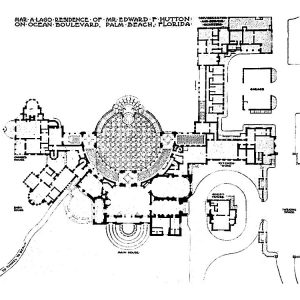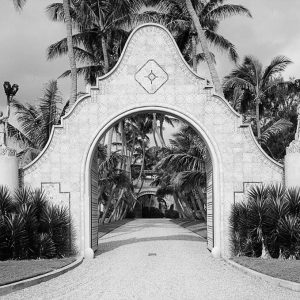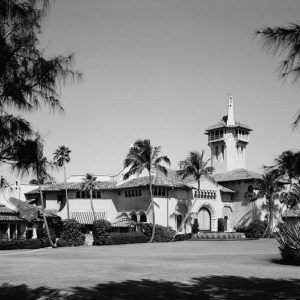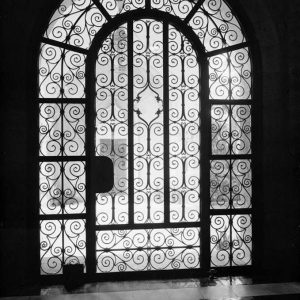Mar-a-Lago Estate, Palm Beach FL
Mar-a-Lago is one of America’s most elaborate 20th century mansions. The site, the style, and a large amount of the decor was personally chosen by Marjorie Merriweather Post (then Mrs. Edward F. Hutton), who had the house built. After searching the area south of Worth Avenue for many months with her agent, Lytle Hull, Mrs. Post found a property which was suitable for the construction of the kind of residence she wanted. The property, overgrown with lush vegetation, consisted of approximately seventeen acres on a coral reef located between the Atlantic Ocean and Lake Worth, The reef provided a firm base for the house which was anchored to it with concrete and steel, and has withstood hurricanes and heavy tropical storms over the years. The name Mar-a-Lago means between sea and lake.
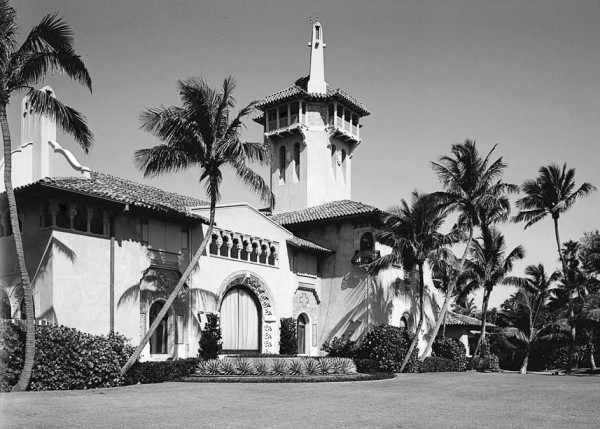
• Jump to the details about Marjorie Merriweather Post, Joseph Urban, Adam Mizner and others on the construction team ≫
Mar-A-Lago is a sprawling Mediterranean-style villa adapted from the Hispano-Moresque style, which was so popular in Palm Beach at the time. It has a two-story central block with family quarters and service areas in one story subsidiary wings and buildings. This arrangement was chosen by Mrs. Post to keep the main house from appearing too massive and to separate the family and service areas from those used for entertaining.
General Description
The ocean facade of the house is rectangular, while on the west side a crescent-shaped arc lined with double cloisters faces Lake Worth. Sheltered in the crescent is a round patio paved with surf-polished stones discovered by Mrs. Post along the beaches of her Long Island hunting preserve at Great South Bay. Carloads of these black, white, yellow, and multicolored stones were shipped to Mar-a-Lago and laid in the pattern of a couryard Mrs. Post had seen at the Alhambra in Spain. The house is topped by a seventy-five foot, tile-roofed tower containing bedrooms and baths and an observation deck commanding a view of Palm Beach for miles around.
Stretching from the house down to Lake Worth are the landscaped grounds including a nine-hole golf course. At one time Mrs. Post brought the Ringling Brothers-Barnum & Bailey Circus to the estate to give a benefit show, and the tents were pitched on this spacious lawn.
The main entrance to the house is through a large gate and coconut palm-lined drive on the Atlantic Ocean side. A stone path and tunnel pass under South Ocean Boulevard to the ocean beach where a private pool and cabanas once served Mrs. Post and her guests. Joseph Urban’s Bath and Tennis Club is also accessible through this tunnel.
The grounds are beautifully landscaped with tropical vegetation and flowers. Potted plants and flowers also profusely adorn the patio and loggias. A citrus grove, greenhouses, a cutting garden, guest houses, and staff quarters are also on the estate. Colored lights in the trees and lanterns in the cloisters accentuate the architecture and foliage at night.
Mar-a-Lago Club
The estate has been completely restored and modernized into the Mar-a-Lago Club with 126 rooms, owned by Donald Trump who acquired the property in 1985 for $10 million. He lived there with his family for ten years and still maintains a private residence there. New facilities have been added for dining and wedding receptions. Outbuildings have been converted into guest suites and bungalows.
The property was placed on the National Register of Historic Places in 1972, and the mansion declared a National Historic Landmark in 1980. The landscape is also preserved with an easement granted to the National Trust for Historic Preservation.
| Mar-a-Lago | Spanish Revival Style |
|---|---|
| 1100 South Ocean Boulevard, Palm Beach FL | |
| National Historic Landmark & National Register of Historic Places (1980) | Private Club |
